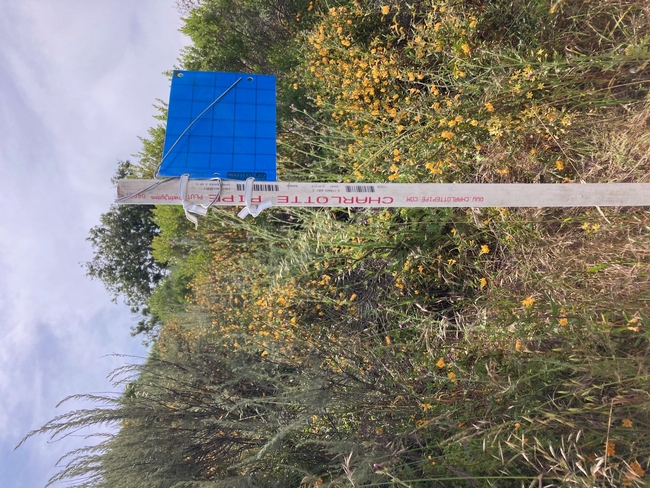“In the coastal areas where spotted wilt is a serious problem ... there is much to be learned concerning the seasonal migrations and local host succession of the thrips”
At first, this looks like a quote from 2020 or 2022 made in reference to the recent outbreaks of Impaciens necrotic spot virus (INSV), a thrips-transmitted disease currently affecting lettuce. But the quote is actually pulled from a UC publication titled Thrips of economic importance in California, authored by Professor Stanley Bailey in 1938.
The lettuce industry here in the Salinas Valley has been hit hard by INSV the past few years, and understanding the biology of the thrips that vectors the virus could be critical for management. But as Bailey noted almost 100 years ago, fully understanding the biology of western flower thrips has been elusive for decades.
In Thrips of economic importance in California, Bailey also noted that thrips in coastal areas tend to spend their summers at higher altitudes, but as native hosts dry up, they can concentrate on nearby crops. I wondered if such a migration could help explain the increase in thrips and INSV pressure the past few falls. With advances in thrips collection methods (i.e., sticky cards) and changes in cropping patterns, I was curious -- could we could observe the migration that Bailey described nearly 100 years ago?

Methods: With help from John Massa (Comgro) and a team from Braga Fresh (Eric Morgan, Katie Chiapuzio, and Jaylen Calabro), I set up a loose transect of 10 sticky card traps at about 4' off the ground (Figure 1). The transect spanned 0.38 miles (610 m) and an elevation change of 325 ft (99 m).
The first traps were deployed on June 5th and the last traps were collected on October 25th. We swapped out cards every two weeks for a total of 10 sets of cards. Some cows used two of the lower traps as scratching posts, so we were limited to 8 traps for most of the trial.
Sticky cards were taken back to the lab to count any thrips that fit the general description of Western flower thrips, Frankliniella occidentalis: less than 2 mm long, overall yellow to brown body color. Some larger, black thrips were occasionally found on traps and were excluded from overall counts.
Hypothesis: Thrips migrate down from the hills in late summer and early fall, increasing the thrips pressure in the valley which could increase the risk of spreading INSV.
Expected Results: If thrips counts are high in the hills in summer, but drop as populations rise in the valley, then this would be good support for Bailey's note and my hypothesis (Figure 2A). Alternatively, if thrips populations in the hills are consistent across time (Figure 2B), or if their population fluctuations match what is going on in the valley (Figure 2C), then it is unlikely that a mass migration is occurring.
Results: The transect results are summarized in figure 3. In panel A, the average thrips per week is plotted over time, with cards grouped by location (top of the hill, middle of the hill, or towards the bottom). The bottom traps were mostly surrounded by dried grass, while the top and middle traps were generally near chaparral plants that stayed green and flowering throughout the summer and into the fall. You can see an increase in thrips captures from June into July, followed by a dip in early august, and two more peaks in mid-August and early October (following that three-day heatwave). Compared to the valley counts (red line), the number of thrips captured on the hill was much higher, an average of 13 times higher than in the Valley. Adjusting the scale of the Valley-level trap counts (Figure 3B), we can see the Valley traps somewhat followed a similar pattern - thrips populations peaked in early June, had a few weeks of low counts in early August, then peaked again in mid-August and early October. With some variation, adult thrips captures in the hills followed a similar pattern to those captured nearby in the Valley.
Preliminary Conclusions: Contrary to my hypothesis, this small study does not provide evidence that thrips migrate en masse from the hills into the Salinas Valley. The hills maintained some green vegetation and flowers throughout the year, so thrips may not be driven to the Valley like Bailey described. Instead, the hills supported high thrips population throughout the summer and into the fall, which may have acted more like a continuous source of thrips into the valley. This could have interesting effects on INSV epidemiology, depending on whether the host plants in the hills can acquire INSV.
We of course cannot rely on a single transect in one year to conclude that thrips never migrate en mass into the Valley. This year we had an atypical, cool, wet spring that may have changed if or how thrips migrate. Perhaps migration only occurs in years with a drier, warmer spring. We also cannot discount the fact that the thrips we counted may not all be Western flower thrips; the identification characteristics we used (less than 2 mm long, overall yellow to brown body color) are not diagnostic of Western flower thrips. The next steps in this study would be to set up additional transects next year and live collection of thrips off of vegetation. By setting up additional transects (and getting them set up earlier in the season), we could determine if this preliminary transect was an anomaly, or if thrips are not behaving the way that Bailey described in 1938. Live collection of thrips is necessary to determine what proportion of thrips in the hills are Western flower thrips that can vector INSV. Either way, we are one step closer to understanding the seasonal migrations and local host succession of thrips, which could help us in our fight against INSV.
Much thanks to John Massa, Eric Morgan, Katie Chiapuzio, Jaylen Calabro, Jasmine Rodriguez, Luis Ramirez-Espinoza, and Carlos Rodriguez Lopez!

